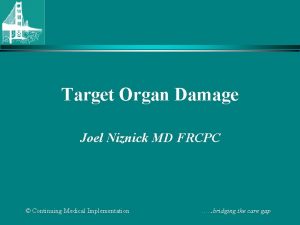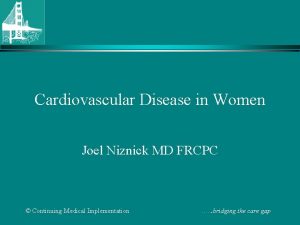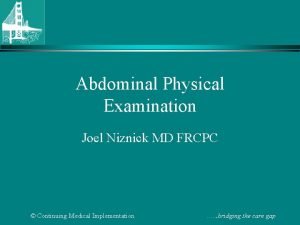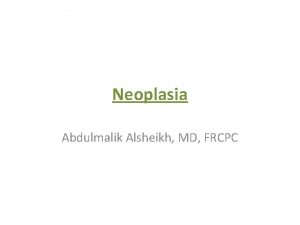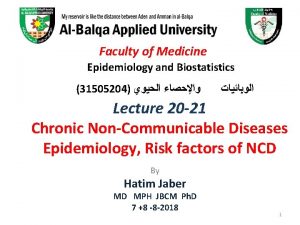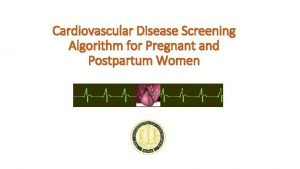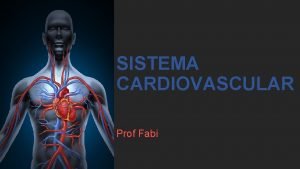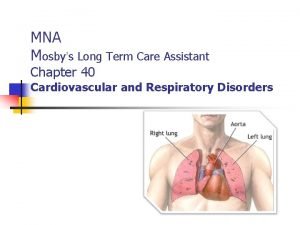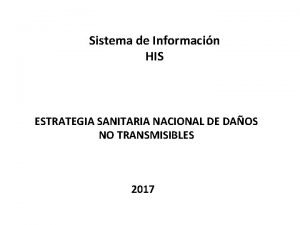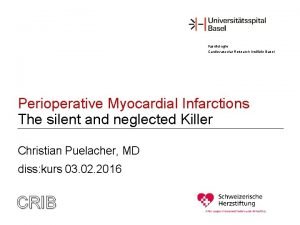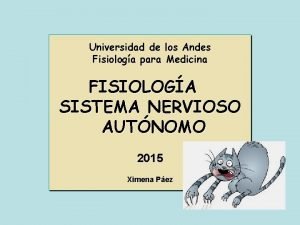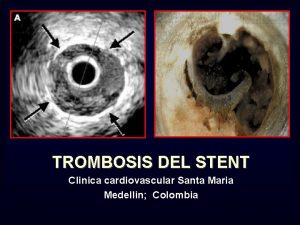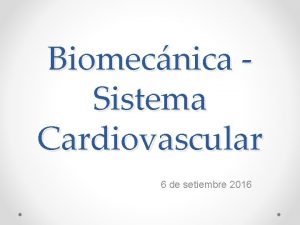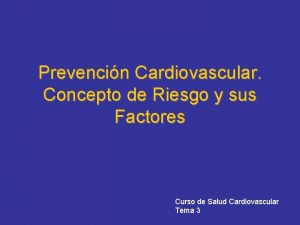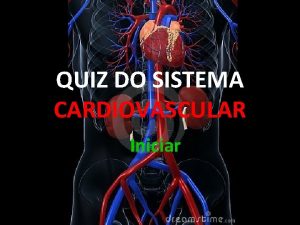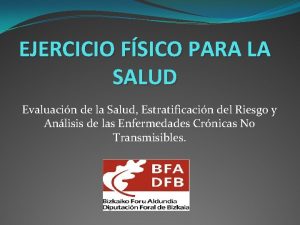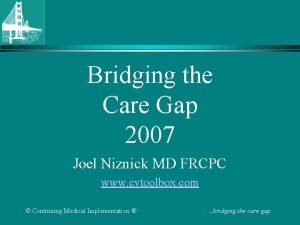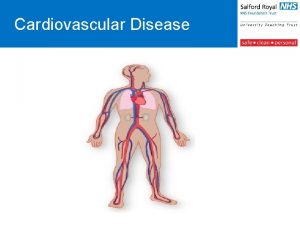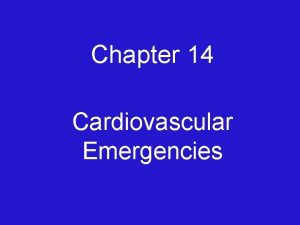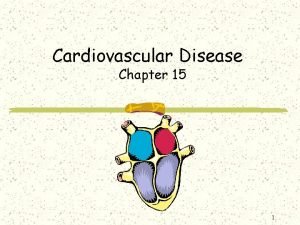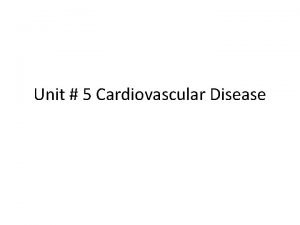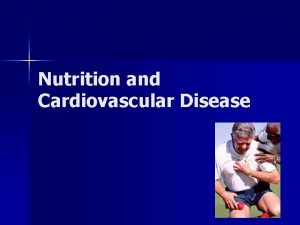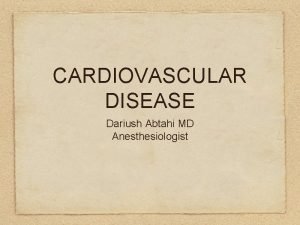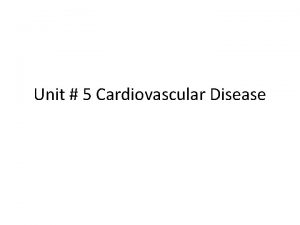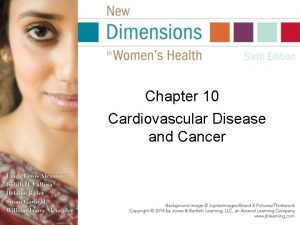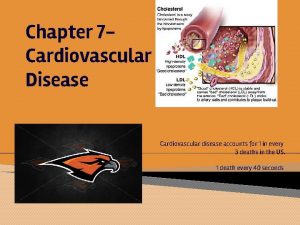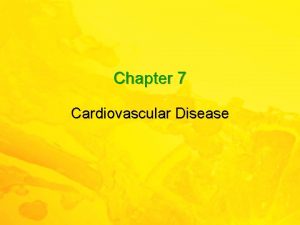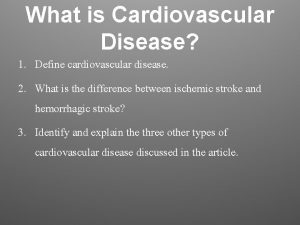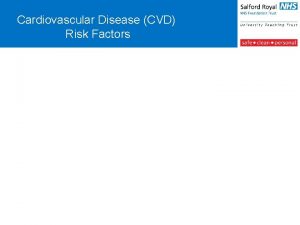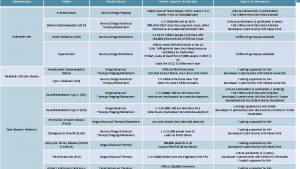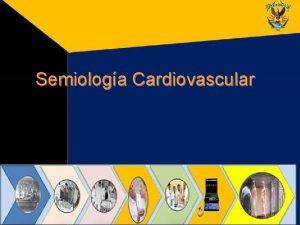Cardiovascular Disease in Women Joel Niznick MD FRCPC































- Slides: 31

Cardiovascular Disease in Women Joel Niznick MD FRCPC © Continuing Medical Implementation …. . . bridging the care gap

Attribution: Some slides adapted from © Continuing Medical Implementation …. . . bridging the care gap

The Heart and Stroke Foundation Fact Sheet –Women • Prevalence – In 2000, 1 in 5 women aged 70 and over were told by a physician that they had heart problems. • Mortality (1999 data) – Coronary artery disease accounted for almost half of all CVD deaths among women. – 9, 038 women died of stroke (8. 5% of all deaths) among women. – More men than women died from coronary artery disease (23, 617 vs. 19, 002) and heart attack (11, 948 vs. 8, 978) – More women than men died from congestive heart failure (CHF) (2, 646 vs. 1, 845). – More women than men died from stroke (9, 038 vs. 6, 371). © Continuing Medical Implementation …. . . bridging the care gap

Risk Factors in Women The Heart and Stroke Foundation Fact Sheet –Women Tobacco Smoking – In 2001, 15% of young women (15 -17 yrs) smoked daily. – In 2001, 16% of women aged 15+ years smoked daily. Physical Inactivity – In 2000, 6 in 10 women were physically inactive. Obesity – In 2000, 14. 2% of women were obese. High Blood Pressure – In 2000, 15. 7% of women aged 20+ reported having high blood pressure. Nutrition: Inadequate Consumption of Vegetables and Fruit – Almost 6 in 10 women consumed less than the recommended amount of vegetables and fruit. © Continuing Medical Implementation …. . . bridging the care gap

© Continuing Medical Implementation …. . . bridging the care gap

© Continuing Medical Implementation …. . . bridging the care gap

Mortality Rates for CVD Declining Faster in Men than Women © Continuing Medical Implementation …. . . bridging the care gap

Mortality Rates in Women Expected to Increase in Next 20 years © Continuing Medical Implementation …. . . bridging the care gap

CAD in Women • Women develop angina about 10 years later and a first MI about 20 years later than men • Women are more likely to have angina than MI as their initial presentation of CAD • Women presenting with acute MI tend to be older and have more co-morbidity • Women are less likely than men to attribute their symptoms to cardiac disease, even in the setting of acute MI © Continuing Medical Implementation …. . . bridging the care gap

Risk Factors in Women -1 Diabetes Mellitus • Diabetes mellitus is a more powerful predictor of CHD risk and prognosis in women than in men • Diabetes is commonly accompanied by other cardiovascular risk factors in women • Diabetes was found to be the only risk factor that distinguished between those with and without angiographic CHD • A history of IDDM is also a strong risk factor in women for death after MI © Continuing Medical Implementation …. . . bridging the care gap

Risk Factors in Women - 2 Hypertension • The prevalence of hypertension reaches 70 to 80 % in women above age of 70 • Hypertension in women is both a strong predictor of coronary risk and more commonly seen in those with CHD • This increase in risk is also seen in premenopausal women in whom the presence of hypertension is associated with up to 10 fold increase in coronary mortality © Continuing Medical Implementation …. . . bridging the care gap

Risk Factors in Women - 3 Smoking • Smoking has been associated with one-half of all coronary events in women • Coronary risk is elevated even in women with minimal use - RR 2. 4 for 1. 4 cigarettes/day ( Douglas and Ginsburg, 1996 ) • Smoking has a more harmful impact on women than on men and that risk increases in direct proportion to the number of cigarettes smoked daily • Smoking carries a particularly high risk in younger women, a population likely to contribute substantially to future burden of CHD © Continuing Medical Implementation …. . . bridging the care gap

Risk Factors in Women – 3 cont’d • Compared with nonsmokers, the incidence of MI was increased 6 -fold in women and 3 -fold in men who smoked at least 20 cigarettes per day • The risk particularly high in younger women – the antiestrogenic effect of cigarette smoking may be one possible explanation for the increased risk of young female smokers (Njolstad et al, 1996) • Smoking is also a powerful risk factor for MI in middleaged women than men • Most of the increased risk induced by smoking dissipates within 2 to 3 years of cessation of smoking © Continuing Medical Implementation …. . . bridging the care gap

Risk Factors in Women – 4 Dyslipidemia • Low HDL, rather than high LDL cholesterol, is more predictive of coronary risk in women • Lipoprotein (a) is a determinant of CHD ( manifested as angina or MI) in pre-menopausal women and postmenopausal women under age 66 (OR 5. 1 and 2. 4, respectively ) • The total cholesterol concentration appears to be associated with CHD only in pre-menopausal women or at high levels • Triglycerides appear to uniquely influence coronary risk in older women, especially at levels above 400 mg/dl (4. 5 mmol/L) © Continuing Medical Implementation …. . . bridging the care gap

Influence of Hormonal Status • CHD is unusual in pre-menopausal women, particularly in absence of other risk factors • If pre-menopausal women develop CHD, the disease tends to be more extensive and diffuse than in men of the same age • Surgical menopause, with or without hormone replacement, carries an added risk of CHD, in excess of that noted for natural menopause • The loss of estrogen causes increase in LDL cholesterol, total cholesterol, TGs and decrease in HDL cholesterol © Continuing Medical Implementation …. . . bridging the care gap

Estrogen Replacement Therapy (ERT): Benefits and Risks - 1 • Normal menopause ~age 51(95% age 45 -55) • ERT best therapy for peri-menopausal symptoms – Duration 6 months to 4 -5 years • Observational studies suggested benefit of ERT or combined estrogen-progestin (HRT) on risk of CHD and development of osteoporosis • Women’s Health Initiative (WHI) July 2002 discounted benefit of HRT for cardiac prevention © Continuing Implementation ERT and. Medical CV Risk I in Up. To. Date, Rose. BD …. . . bridging the 2004 care gap (ed), Wellesley, MA

Estrogen Replacement Therapy (ERT): Benefits and Risks - 2 WHI Studies • Combined estrogen/progestin replacement 1 – > 16, 000 post menopausal women age 50 -79 – Terminated early with average f/u 5. 2 years – Increased risk breast cancer, stroke, CHD (HR 1. 24) and VTE • Unopposed estrogen trial 1 – > 11, 000 women with prior hysterectomy – Received unopposed estrogen – Study discontinued early due to increased risk of stroke and no projected overall benefit NEJM 2003 Aug 9; 349(6): 523 -341. © Continuing Implementation ERT and. Medical CV Risk I in Up. To. Date, Rose. BD …. . . bridging the 2004 care gap (ed), Wellesley, MA

Estrogen Replacement Therapy (ERT): Benefits and Risks - 3 • HERS I (Heart and Estrogen/Progestin Replacement Study) – 2763 post-menopausal women < 80 with CAD – CEE/progesterone vs placebo – followed for 4 years – No difference in CHD events overall – More CHD events in HRT group in year onetrend to benefit in years 4 -5 © Continuing Implementation ERT and. Medical CV Risk I in Up. To. Date, Rose. BD …. . . bridging the 2004 care gap (ed), Wellesley, MA

Estrogen Replacement Therapy (ERT): Benefits and Risks - 4 • HERS II – Un-blinded follow-up of 93% patients in HERS I for 2. 7 years – No ongoing HRT benefit beyond years 4 -5 – Over 6. 8 years in HERS I & II no benefit of HRT © Continuing Implementation ERT and. Medical CV Risk I in Up. To. Date, Rose. BD …. . . bridging the 2004 care gap (ed), Wellesley, MA

Estrogen Replacement Therapy (ERT): Recommendations • Estrogen-progestin therapy should not be prescribed for primary prevention of CHD. • Estrogen-progestin therapy should be discontinued if an acute CHD event occurs, and should not be resumed as a secondary prevention strategy. • Unopposed estrogen, although it does not appear to increase CHD risk, should not be prescribed for primary prevention because no reduction in CHD risk was observed in the WHI trial. • Estrogen or estrogen-progestin therapy should be reserved for peri-menopausal women with moderate to severe menopausal symptoms. The lowest estrogen dose that relieves symptoms should be used for the shortest duration possible. © Continuing Implementation ERT and. Medical CV Risk I in Up. To. Date, Rose. BD …. . . bridging the 2004 care gap (ed), Wellesley, MA

Women Have An Atypical Clinical Presentation • Typical retrosternal chest pain less common • Atypical symptoms and location – Resting, nocturnal or stress induced chest pain – Jaw, arm, shoulder, back, epigastric discomfort – Dyspnea, palpitations, presyncope – Fatigue, diaphoresis, nausea © Continuing Medical Implementation …. . . bridging the care gap

Gender Bias or Clinical Conundrum? • Women who present to the emergency room with new onset chest pain are approached and diagnosed less aggressively than men • Compared to men women are less likely to: – undergo an EKG, cardiac monitoring or cardiac enzyme measurement – to receive a cardiology consult; be admitted to a coronary care or step down unit • Women are more likely to receive controlled substances and anxiolytics in the ER © Continuing Medical Implementation …. . . bridging the care gap

Comparison of Men and Women in Presentation and Outcome Presentation Comparison Outcome Comparison Angina W>M MI morbidity W > M Atypical CP W>M MI Mortality W > or = M Silent MI W>M CABG Mort. W > or = M Death from MI Sudden death W>M PCI Mortality W > or = M False + TMT W>M AP MI W<M W>M © Continuing Medical Implementation …. . . bridging the care gap

Approach to diagnosis CAD in Women • • Classify the type of pain Assess determinants of likelihood of CAD Select test based on pre-test probability of CAD Confirm or deny presence of CAD with TMT, stress perfusion study or stress echo • High false positive rate TMT rate in premenopausal females (up to 50%) or low pre-test likelihood CAD © Continuing Medical Implementation …. . . bridging the care gap

Classification of Chest Pain Typical angina 1. Steady retrosternal component 2. Provoked by exertion or stress 3. Relieved by rest or NTG Atypical angina – 2 of 3 criteria Non-anginal chest pain – 1 of 3 criteria © Continuing Medical Implementation …. . . bridging the care gap

Prevalence of CAD (%) in Symptomatic Patients According to Age and Sex Typical angina Atypical angina Non anginal chest pain AGE Men Women 30 -39 69. 7 25. 8 21. 8 4. 2 5. 2 0. 8 40 -49 87. 3 55. 2 46. 1 13. 3 14. 1 2. 8 50 -59 92. 0 79. 4 58. 9 32. 4 21. 5 8. 4 60 -69 94. 3 90. 6 54. 6 28. 1 18. 6 3 of 3 criteria 2 of 3 criteria 1) Retrosternal discomfort. 2) Provoked by exercise or stress. 3) Relieved by rest or NTG © Continuing Medical Implementation …. . . bridging the care gap

Determinants of the Likelihood of CAD in Women MAJOR - Post menopausal status / age >65 years - Diabetes - Peripheral Vascular Disease INTERMEDIATE - Hypertension - Smoking - Lipid abnormalities © Continuing Medical Implementation MINOR - Obesity - Sedentary lifestyle - Family history of CAD - Other risks factors of CAD …. . . bridging the care gap

Algorithm for Chest Pain Evaluation in Women Low Probability of CAD (< 20 %) – Consider no test – High likelihood false + result Intermediate Probability of CAD (20 -80%) – Perfusion imaging or stress echo High Risk Probability of CAD (> 80%) – Perfusion imaging or stress echo – Consider direct angiography © Continuing Medical Implementation …. . . bridging the care gap

Comparison of Non-invasive Modalities in the Diagnosis of CAD in Women Sensitivity % Specificity % TMT 61 70 Stress Thallium 78 64 SPECT MIBI 86 80 Stress Echo 86 70 80 (SVD) 91 (MVD) 79 91 90 Dobutamine Echo Rubidium PET Meta-analysis of exercise testing to detect coronary artery disease in women Kwok Y. Kim C. et al Am J Cardiol 1999. Mar 1: 83(5); 660 -6. © Continuing Medical Implementation …. . . bridging the care gap

Indications for Coronary Angiography • High risk stress test – ECG – Hemodynamic • High risk perfusion study – Multiple defects – Severe perfusion defects – TID © Continuing Medical Implementation • • • Ongoing symptoms Unstable angina Post MI angina CHF Vocational indication – Pilots – Truck/bus drivers • Diagnostic uncertainty …. . . bridging the care gap

See Diagnostic Testing 2004 Slideshow © Continuing Medical Implementation …. . . bridging the care gap
 Joel niznick
Joel niznick Joel niznick
Joel niznick Psoas sign
Psoas sign Neoplasia
Neoplasia Hnpc
Hnpc Anatomy blood vessels
Anatomy blood vessels Cardiovascular disease risk factor
Cardiovascular disease risk factor Communicable disease and non communicable disease
Communicable disease and non communicable disease Rias de hipertension arterial
Rias de hipertension arterial Ptca
Ptca Lesson 11 cardiovascular system
Lesson 11 cardiovascular system Cmqcc cardiovascular toolkit
Cmqcc cardiovascular toolkit Crash course circulatory system
Crash course circulatory system Pequenos vasos sanguineos
Pequenos vasos sanguineos Wheezing
Wheezing Anatomy and physiology unit 7 cardiovascular system
Anatomy and physiology unit 7 cardiovascular system Riesgo cardiovascular por perimetro abdominal
Riesgo cardiovascular por perimetro abdominal Cardiovascular research institute basel
Cardiovascular research institute basel Receptores sensoriales
Receptores sensoriales Clinica cardiovascular santa maria
Clinica cardiovascular santa maria Bhf glasgow cardiovascular research centre
Bhf glasgow cardiovascular research centre Wolters kluwer
Wolters kluwer Sistolw
Sistolw Aparato cardiovascular
Aparato cardiovascular Chapter 16 cardiovascular emergencies
Chapter 16 cardiovascular emergencies Pithed rat
Pithed rat Salud cardiovascular
Salud cardiovascular Lesson 11 cardiovascular system
Lesson 11 cardiovascular system Medical terminology chapter 5 learning exercises answers
Medical terminology chapter 5 learning exercises answers Sistema cardiovascular quiz
Sistema cardiovascular quiz Prairie cardiovascular consultants springfield il
Prairie cardiovascular consultants springfield il Estratificacion de riesgo cardiovascular acsm
Estratificacion de riesgo cardiovascular acsm
